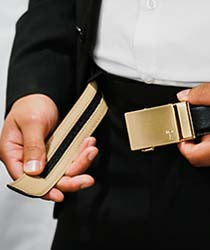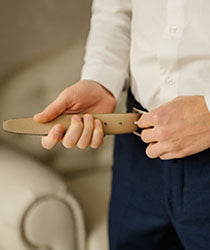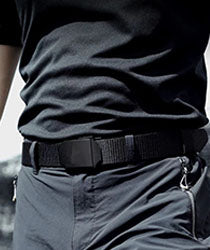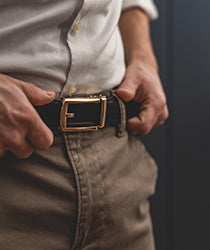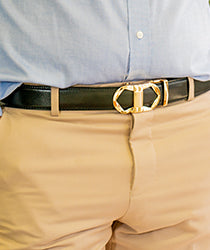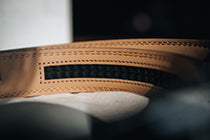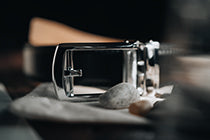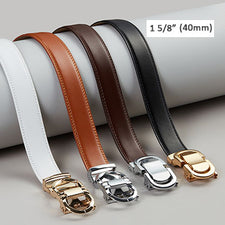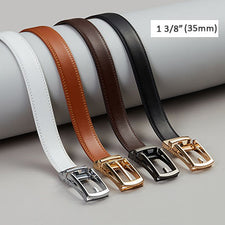You know what's the worst? When you're out, and the belt you have on is too big. Not only does it look like an accident, but it can be uncomfortable and keep slipping off.
So what do you do? You try to find a new belt that fits. But then, once again, the problem arises: What size belt do I need?
Well, if you've ever had this problem or just want to learn more about belts, you're in luck. This article will teach you how to measure for a new belt- from start to finish!
Waist size/pant size does not equate to belt size!
Are you one of those who think that your pant size is the same as your belt size? I must inform you that you are mistaken! Your pant size and belt size are not the same.
Your waist size determines your pant size, not your hip measurement. And most importantly, your belt should be worn on your natural waistline - which is usually about an inch or two above where pants sit on your hips. So if you're wearing pants that are too big in the waist, chances are good that they'll also be too big in the seat and thighs - and vice versa for pants that are too small in the waist.
What's more, different brands can have very different sizing standards. So a pair of jeans from Brand A might fit perfectly while a similar-sized pair from Brand B would be too tight or too loose. So, your belt size would greatly vary that way too!
What size belt should I look for?
When it comes to belts, size matters. A belt that is too big or too small can ruin your look and make you feel uncomfortable all day long. So what size belt should you get?
The general rule of thumb is that your belt size should be two inches larger than your pant size (waist size). For example, if you wear 34-inch waist pants, add 2 inches, and you would need a 36-inch belt. This will ensure that the belt fits snugly around your waist without being too tight or loose.
However, this method is not recommended nowadays! Since there's a vast difference in sizing between clothing brands, the general method of +2 won't always work. So, we highly recommend that you thoroughly measure yourself before purchasing a new belt.

How to calculate belt size with a measuring tape?
What all you need:
- A cloth measuring tape
- Your desired outfit
- A mirror
Step 1: Put on the clothing that you intend to wear with your new belt. Make sure the pants sit at your natural waistline - this is usually about an inch above your belly button.
Step 2: Weave the cloth tape measure through the belt loops of your pants and around your body until it meets in front at center. Again, ensure the tape measure is level all around and snug against your skin but not too tight. You should be able to slip two fingers underneath it comfortably.
Step 3: Now, in that form, take the tape measurement. Remember to take measurements to the nearest quarter inch. It's very important to take the correct measurements; take the help of a mirror or even a friend if necessary!
Step 4: Consult a proper belt size chart. Your belt size should be pretty close to the waist size measurement you just took. Below is the belt size chart!
|
Belt Size |
Recommended For |
Body Measurements (In) |
|
34 |
Men’s US Jean Size 31-32 |
32.5-37.5 |
|
36 |
Men’s US Jean Size 33-34 |
34.5-39.5 |
|
38 |
Men’s US Jean Size 35-36 |
36.5-41.5 |
|
40 |
Men’s US Jean Size 37-38 |
38.5-43.5 |
|
42 |
Men’s US Jean Size 39-40 |
40.5-45.5 |
Can you just measure your current belt for your size?
You can absolutely measure your current belt to determine your belt size! All you need is a flexible measuring tape and something to mark the spot where you want the end of the belt to fall. Once you have those two things, simply follow these steps:
- Wrap the measuring tape around your waist, ensuring it's snug but not too tight. Mark the spot where the tape ends meet with a pen or pencil.
- Unwrap the measuring tape and lay it flat on a surface. Measure from one end of the tape (the part that was wrapped around your waist) to your mark - this is now your belt size in inches!
- To find out what size belt you should purchase, consult a sizing chart like the one above. Find your measurement on the chart, and voila -you know exactly what size belt to buy!
FAQs related to the belt size
1. What should be the ideal belt size for 32-inch waist size pants?
There's no definitive answer to this question since belt sizes can vary depending on the brand, style, and materials used. However, a good rule of thumb is choosing a belt two inches wider than your waist size.
So for a 32-inch waist size, an ideal belt size would be 34 inches. However, if you're wearing pants made of stretchy fabric, you may want to go up one or two sizes (to 36 inches) to ensure a comfortable fit.
2. Is it recommended to measure your belt size yourself?
In general, it is not recommended to measure your belt size yourself. This is because you may not be able to get an accurate measurement (like your waist size), which could lead to buying the wrong-sized belt.
If you are unsure of your belt size, it is best to consult a professional who can help you determine the correct size. There are many online retailers that offer sizing charts or guides that can assist you in finding the right fit.
Additionally, most stores that sell belts will have staff members who can help with sizing if needed!
3. Can I buy a belt for him without knowing his waist size?
Yes, choose a ratchet belt, one size fits all most adjustable belt.
Tonywell ratchet belt allows following instructions to trim to fit 32 to 45 inches waist size. The ratchet system without holes on the belt ensures you won‘t have your leather split from hundreds of donning and doffing of the belt and the bending of the strap that comes with a conventional belt with holes.
And the hidden track is able to adjust these belts in very small increments, with no center hole that is too loose or tight.

Conclusion
So, there you have it! That's how you can find your ideal belt size.
We hope this article helped you, and if it did, do consider sharing it. Also, stay tuned for more informative articles!
Ready to dress sharp and command respect with the right accessory? Click here to discover Tonywell, the Professional Accessories Supplier.

